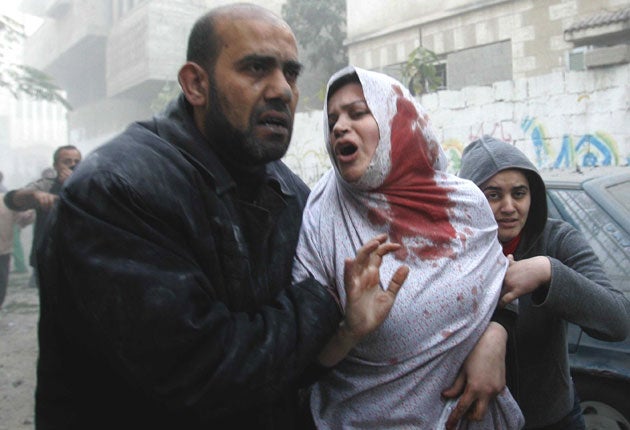Kim Sengupta: Claims that Israel is using illegal bombs won't go away

The UN's accusation that Israel used white phosphorus shells in its attack on its headquarters in Gaza was the first direct charge by an international body and, in effect, accuses the Israeli government of lying over its repeated declaration that its forces adhere to international laws in the use of arms.
The attack on the UN headquarters in Gaza City has been internationally condemned. Any proof that white phosphorus shells were used would add to the call for Israel's military forces to be charged with war crimes.
Chris Gunness, a spokesman for the United Nations Relief and Works Agency (UNRWA), claimed within hours of the attack that three such shells were responsible for injuries to three of its employees. While it is not illegal to use different types of white phosphorus shells as a tactical weapon – usually to create a smokescreen ahead of advancing troops or for illumination at night – the Geneva Treaty of 1980 specifically bans it use in densely populated areas because it can cause severe burns.
The Israelis admitted they had used white phosphorus against "military targets" on open ground during the Lebanese war of 2006. The US and Britain also used the weapons mixed with high explosives – so-called "shake and bake" – in Iraq. American forces in particular used white phosphorus in the second siege of Fallujah in 2004 but insisted that it had been used only for illumination purposes.
The charge that the Israelis were using white phosphorus in the current conflict surfaced soon after the start of the air offensive on 27 December. The Israeli military responded with what has been their standard line – "Israel uses munitions that are allowed for under international law".
Yesterday, a spokesman for the defence ministry in Jerusalem said the claims were under investigation but reiterated that Israeli forces continued to follow the policy of abiding by international law in the use of weapons. However, Human Rights Watch said its experts in the region had witnessed the use of white phosphorus.
Kenneth Roth, the organisation's executive director, added: "This is a chemical compound that burns structures and burns people. It should not be used in populated areas.
"Even if Israel might have some minor chemical variation of white phosphorus so that the thing they're using has a new name, the effect is absolutely the same."
However, asked on Wednesday specifically whether there was evidence of injuries to civilians caused by such weapons, the president of the International Committee of the Red Cross, Jakob Kellenberger, who had just returned from a trip to Gaza City said his organisation had found "no evidence" of that. He added: "We have officials at Shifa Hospital and they have not come across injuries which could be proved to be from white phosphorus. This is just from one hospital, but it is the largest hospital in Gaza."
There were reports yesterday that remnants of a white phosphorus shell, identified by the marking M825A1 on the outer casing, had been found at Sheikh Ajilin village in western Gaza. Local people said the shell was fired on 9 January and recalled seeing thick smoke and noticing a garlic-like smell, which is consistent with the use of white phosphorus. Robert Emerson, a military analyst, said: "The Geneva Act leaves areas of confusion on this. It says white phosphorus should not be used against targets in densely populated areas.
"However, a shell meant to explode in the air may go astray and hit civilians. Similarly, a shell used against military targets in relatively open ground can cause collateral damage.
"However, questions are obviously being asked about the UN attack and the [Israeli Defence Forces] may have to think again about their whole policy on white phosphorus if it is indeed proved that white phosphorus was used on this occasion."
View from Gaza: The ambulance driver
Sharon Lock, an Australian from the International Solidarity Movement, was working as an ambulance driver for the Palestinian Red Crescent when its Al-Quds Hospital in Gaza City came under Israeli attack yesterday.
"One shell landed outside the building about 10 yards from the incubators for new babies. We were putting fires out with buckets of water. The shrapnel seems to burn for a long time and it starts fires if it is not put out. We were just dealing with that when we heard shooting from the front steps of the hospital and my colleague Mohammed came to me covered with blood. 'Israelis are shooting at people who are leaving their houses,' he said. What happened was that a father and mother and two daughters had left their home, one of the daughters had gone missing and the other was shot. The bullet went through one cheek and out the other. As the father was coming up the steps he fell, shot as well. They didn't know where the other daughter was. Mohammed and I decided to go out and find her. We found her hiding in a house. I would say she was about nine. She was very frightened."
Join our commenting forum
Join thought-provoking conversations, follow other Independent readers and see their replies
Comments